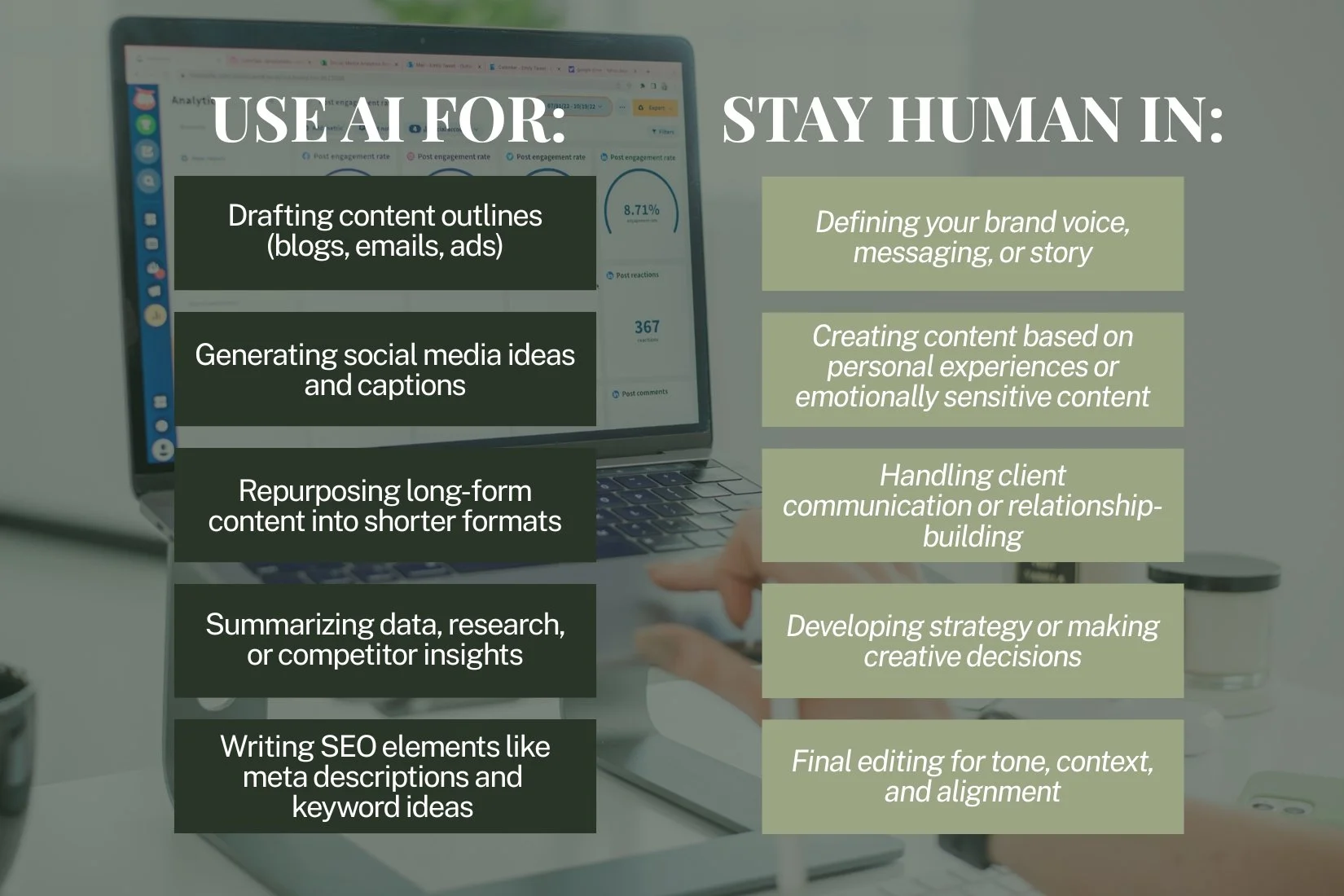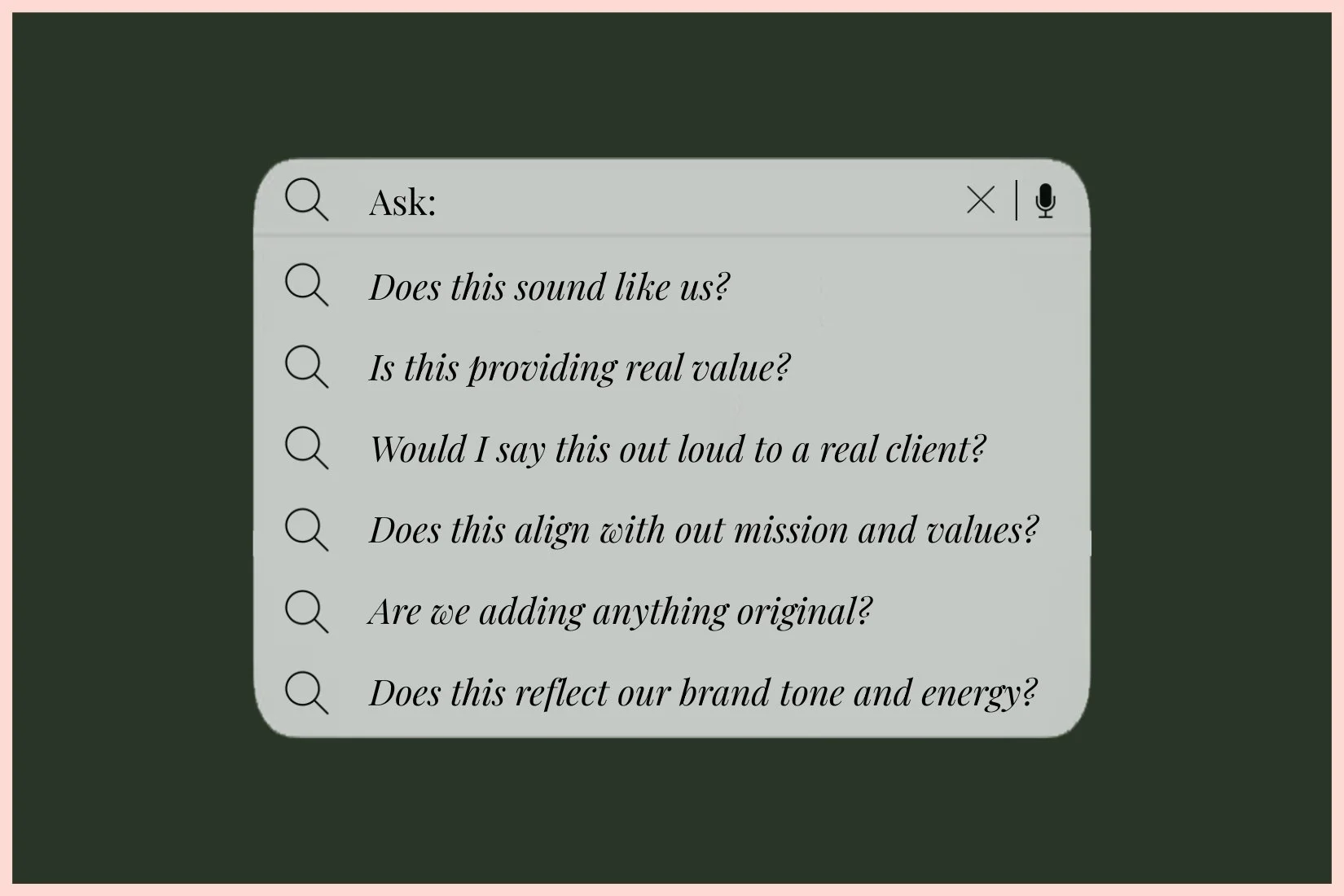
How to Balance AI and Personalization in Your Marketing Strategy
July 11, 2025
There’s no denying that AI is transforming how we market and grow our businesses. It’s fast, efficient, and increasingly capable of handling everything from content drafts to customer journeys. However, as automation becomes more common, something else is becoming increasingly rare: marketing that genuinely feels personal.
The key to modern marketing lies in knowing how to balance AI and personalization in marketing effectively.
In a world saturated with content, automation, and noise, people crave real connection. Overusing AI can make brands feel robotic, generic, or even deceptive. Audiences are more likely to engage with brands that feel human, clear, and trustworthy.
The most successful brands create a sense of connection by showcasing real people, real stories, and real value. They know how to leverage tools like AI without sacrificing what makes them unique. In fact, brands that implement personalized marketing tactics earn 40% more revenue (McKinsey & Company).
Learning to balance AI and personalization in marketing strengthens the human connection your brand is built on. In this blog, we’ll explore how to bring clarity and intention to your marketing by utilizing AI as a tool, while maintaining the authenticity and personal touch that sets your brand apart.
Start with Clear Strategies
AI in marketing is powerful when used with intention. Before introducing AI into your marketing, get clear on the strategy it’s meant to support. Tools can help you move faster, but without direction, you’re just producing more content with less impact. A strong strategy ensures every message, campaign, and automation aligns with your brand’s purpose and goals.
Action Steps:
1. Define your marketing strategies, tactics, and goals.
2. Document your content strategy before plugging it into any AI tools.
3. Establish clear guidelines and workflows to ensure everyone on your team uses AI intentionally.
4. Ask yourself, “What kind of experience do we want to create for our audience?”
AI should amplify your clarity, not create more noise. Let strategy lead, and let the tools follow.
Let AI Handle the Right Tasks
AI is a time-saver, not a brand-builder. Successfully learning to balance AI and personalization in marketing means letting AI handle repetitive, operational tasks so you can focus on the aspects of your marketing that build real connections: the messaging, the strategy, and the relationships.
Automate scheduling, drafting, or data analysis. But when it comes to storytelling, client communication, and moments that require empathy, people still want to hear from people.
Action Steps:
1. Audit your current marketing workflow.
2. Identify tasks that are repeated weekly or monthly.
3. Test AI tools for things like outline generation, content repurposing, or caption drafts.
4. Create a simple rule: “If it requires judgment or emotional nuance, it stays human.”
Efficiency matters, but connection is what creates momentum. AI can support your growth, but trust still comes from showing up with intention.

Identify Your Human Touchpoints
When incorporating AI into marketing, it’s essential to determine where you still need to be present. Not everything should be automated; some moments call for a real human touch. These are the touchpoints where trust, emotion, and connection matter most.
Think about client onboarding, sales conversations, personalized emails, social DMs, or video messages. These are moments where people want to feel seen and heard. Keep your voice present in content that shares your story, showcases behind-the-scenes moments, or responds to client questions. When it comes to building relationships, human presence always wins.
Action Steps:
1. Map out your whole customer journey and mark the points where human interaction matters most.
2. Keep things like discovery calls, follow-ups, and client check-ins personal.
3. Use your voice for welcome emails, thank-you notes, and videos that share your story.
4. Make sure a real person is responding to comments, DMs, and inquiries on your platforms.
Keep Your Brand Messaging Consistent
To maintain consistent brand messaging when using AI, begin with a solid foundation. The ability to balance AI and personalization in marketing starts with clearly defining your core message — what you do, who you serve, and why it matters. Ensure that your value proposition and key talking points are well-documented and easily accessible to your team.

AI can help you scale your messaging across different platforms, but it needs guidance. Without clear direction, it may create content that sounds off-brand or inconsistent. That’s why it’s important to give AI the right inputs and always review the outputs with a human eye.
Action Steps:
1.Create a messaging framework that includes your core message, audience pain points, and brand vocabulary.
2. Use AI for content drafts, repurposing, or idea generation, but ensure a human refines and approves the final copy.
3. Provide AI with approved prompts, examples, and messaging guidelines to stay aligned.
4. Regularly review content across platforms to ensure your message stays clear, relevant, and consistent.
Think of AI as a helpful assistant, not the final decision-maker. The goal is to speed up content creation without losing clarity or connection.
Review and Refine All AI Content
AI can be a powerful tool, but it’s not perfect. It doesn’t fully understand your audience, your tone, or the deeper meaning behind your message. The most effective way to balance AI and personalization in marketing is to ensure that everything AI creates goes through a human review before it goes live.
Your job is to bring clarity, personality, and strategy to what AI gives you. Edit for tone, double-check facts, and make sure the message aligns with your brand.
Action Steps:
1. Treat AI output as a draft, not a final version.
2. Review for tone, clarity, and accuracy before publishing.
3. Ensure the content aligns with your brand’s voice and core message.
4. Monitor performance over time and adjust prompts or edits as needed to optimize results.
AI can help you get started, but your final touch is what makes it practical and trustworthy.
Finding the Right Balance
AI can help your brand grow, but only when it’s grounded in clarity and guided by your mission. The most effective marketing isn’t just driven by metrics. It’s shaped by values, aligned with your message, and built to create a real connection.
Finding the right way to balance AI and personalization in marketing means knowing where to automate and where to show up yourself. Let AI handle the repetitive work so you can focus on what matters most — building trust, sharing your story, and connecting with your audience in a meaningful way.
Start with clarity. When your message is clear, it’s easier to identify:
1. What your marketing goals are
2. What tasks can be automated
3. Where human connection should happen
4. How to stay consistent across every platform
At Well+Defined, we help high-value brands with lean teams simplify their marketing, clarify their message, and grow in a way that reflects the quality of their work. Our approach blends strategy, storytelling, and innovative tools to help you scale without losing the heart of your brand.
Ready to find your balance?
Book a free 15-minute consultation. No pressure, just a quick conversation about how we can support your growth with a clear and intentional strategy.